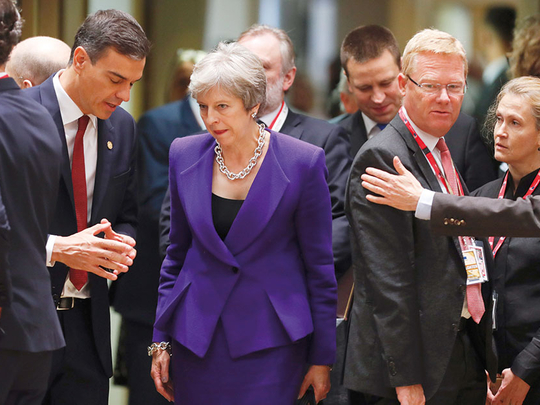
Madrid: British Prime Minister Theresa May has suggested that the United Kingdom may seek more time to smooth the transition period after her nation leaves the European Union on March 29 — should her government indeed reach any deal with Brussels in the next six weeks.
But the prospect of reaching a deal is not yet sure, with both the EU and the London government far apart. Meeting in Brussels with the EU on Wednesday night, May had little to offer the increasingly sceptical Europeans other than to suggest the time from when the UK formally leaves the EU on March 29, and the December 31, 2020 date for the end of the transition period might be extended for some months.
- Theresa May | British Prime Minister
But even that creates more political difficulties for May who has little room to manoeuvre politically. Her Conservative party is deeply split between hard-line Brexiteers who want the UK out of Europe as quickly as possible, and Remainers, who are seeking closest possible relationship between London and the EU after the split.
Complicating matters for May is that she relies on 10 MPs from the Democratic Unionist party of Northern Ireland, who are vehemently opposed to any Brexit agreement that might weaken the province’s relationship with the rest of the UK.
- Sebastian Kurz | Austrian Chancellor
With time running out, the border between Northern Ireland and the Republic of Ireland remains the intractable hurdle for negotiators. Brussels is determined that the border remains open, free of customs and security checks and honouring the terms of the Good Friday Agreement of 1998 that brought three decades of political and sectarian violence to an end.
The scenarios
The hard Brexit: No deal between the EU and the UK can be reached by mid-December
Should the EU and the UK fail to reach a deal, there is simply no time left for European governments and the European Parliament to ratify any agreement before March 29.
This ‘hard Brexit’ would mean that World Trade Organisation rules apply, generally adding 8 per cent tariffs on most goods and services moving between the UK and Europe.
According to planning papers already issued, the ramifications would be huge, with car manufacturers warning that 800,000 jobs could be at risk.
Because the EU regulates flights, all air traffic between the UK and Europe could be grounded for weeks, while the Bank of England Governor Mark Carney warns that house prices across Britain would plummet by one-third. Generally, it would be political, economic and socially chaotic.
The upside is the UK would be free to pursue its own trade deals, free from oversight from Brussels.
The soft Brexit: An agreement that’s orderly and best suits both the EU and the UK
In an ideal world, this mutual and orderly deal allows for a smooth transition for Britain to end its 45 years’ marriage with the EU, allowing the political, social and economic bloc to keep a close relationship in all areas with the United Kingdom.
The reality is that after months of talking, there is little likelihood for this to occur.
While it’s best favoured by the Remainers in May’s Conservative party, there is a group of 50 or so MPs in the so-called European Reform Group who want a sharp, clean break, allowing the UK to go it alone in making trade deals and “taking back control” of rules.
The best possible scenario — and avoiding any border checks in Northern Ireland — would be for the UK to remain in the wider European Economic Area, or customs zone, that includes Iceland, Switzerland, Norway and Liechtenstein and the EU28. Doing that, however, would be that the UK would remain “a rule taker”, not a “rule maker”.
The blind Brexit: A deal that’s soft around the edges, long on future intent, short on details
As negotiations stand now, the last remaining hurdle between both sides is an agreement on the border between Northern Ireland and the Irish Republic. With time is running out, both London and Brussels may be willing to agree to cover off most of the issues, but write soft language and commitments on the border.
This is a hard sell for May to those who feel it will not honour the sentiment of the referendum decision to leave the EU quickly.
Last December, the UK committed to keeping Northern Ireland in “regulatory alignment” with the rest of the EU. But because of May’s reliance on the DUP, that means she faces intense opposition to any move that singles the province out for special treatment. She needs to satisfy the DUP while keeping the EU onside as well.
President Emmanuel Marcon of France and others have expressed opposition to the blind Brexit, wanting Brexit wrapped up one way or another — and the sooner the better.
EU cancels Brexit summit in November
The leaders of the 27 countries that will remain in the European Union (EU) after Britain’s withdrawal called off an extraordinary summit on the Brexit in November due to insufficient progress to organise the meeting.
“For now, the 27 are not planning to organise an extraordinary summit on Brexit in November,” European sources said. EU leaders stand “ready” to convene a European Council, “if and when” the EU’s chief negotiator, Michel Barnier, reports that “decisive progress” has been achieved, Efe News reported.
The Heads of State and Government of the 27 met in Brussels on Wednesday to hear a statement delivered by the British Prime Minister Theresa May, on the Brexit and then, without the UK, discussed how to proceed with the negotiations less than six months away from the planned British exit.
Brussels had planned to close the withdrawal agreement with the British government in October so that the European Parliament and Westminster could ratify it before March 29, as per the current schedule for Brexit.
— Agencies












